Lincoln Technical Institute students welcome to attend CPR classes
Lincoln Technical Institute Group of schools CPR Training Classes

 – Dental Assistant-Nursing-Pharmacy Technician-Surgical Technology-Medical Assistant with Basic X-Ray
– Dental Assistant-Nursing-Pharmacy Technician-Surgical Technology-Medical Assistant with Basic X-Ray
Americare School of Nursing CPR
Fern Park Orlando Campus CPR training
Lincoln Technical Tampa Campus CPR classes
We have a large amount of nursing and dental students who take our classes over an equivalent college offered course. Please be assured that all nursing, EMT, or dental programs in the area will accept our program to fulfill your CPR requirements. When signing up please select a BLS for Healthcare course .
At In-Pulse CPR we take pride in our quality of teaching. We use the latest technology and state-of-the-art equipment to provide for an interactive, experiential learning environment. We make sure that each student leaves the classroom feeling confident in the skills they gained. Our classes are fun too!
We offer CPR certification at over 13 locations across central Florida.
Click here to View our Class Calendar 
We offer the following certifications:
Heartsaver CPR
Heartsaver AED
BLS Healthcare CPR / Heath care Professional – This is the certification Lincoln Technical Institute medical students would need to register for. These classes are showing in yellow on our calendar.
Heartsaver First Aid
and More…
If you have recently attended a CPR class with In-Pulse CPR we want to hear from you. Please post your comments below:





